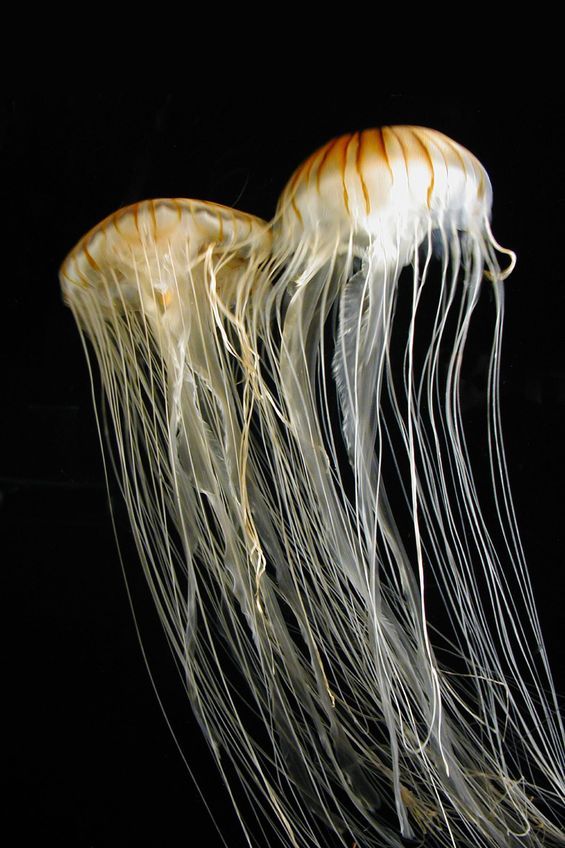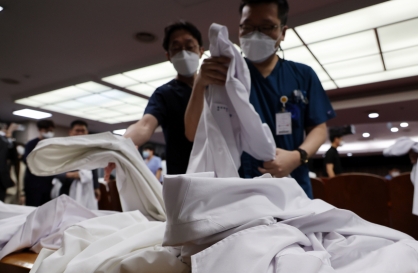The Ministry of Food, Agriculture, Forestry and Fisheries said that it aims to eradicate the jellyfish by exploring ways to extract collagen from the creatures to produce commercial cosmetics.
To that end, the ministry has asked the National Fisheries Research and Development Institute to conduct research to find a way to carry out the plan. If the research turns out to be commercially viable, the fishing industry will reap benefits from sales as well as a less volatile sea.

Jellyfish have become a growing concern for Korean policymakers, vacationers and residents living in coastal areas. The ministry has been battling to control the fast spread of jellyfish in recent months, a phenomenon reportedly linked to abnormally high water temperatures.
“Various measures will be implemented to minimize the threat of jellyfish which has posed a threat to both the fishing industry and human lives,” said an official at the ministry.
An 8-year-old girl playing at a beach near Incheon died on Aug. 10 after a jellyfish stung her. In addition, 45 vacationers at Busan’s Haeundae Beach were attacked last Wednesday.
Jellyfish are estimated to cost as much as 300 billion won ($264 million) annually to the local fishing industry.
Up until now, the Korean government has had few options to grapple with the threat. Even if fishing boats catch jellyfish, they are dumped back into the ocean since they presently hold no value as food or for industrial ingredients.
Meanwhile, the ministry said it plans to purchase jellyfish caught during fishing in order to minimize secondary damage when jellyfish get dumped back into the ocean.
Near the waters of Shinan and Gunsan in South Jeolla Province alone, authorities have removed a total of 214 tons of jellyfish. The ministry said it has set aside 1.9 billion won for the jellyfish purchase program this year and will secure a bigger budget if the problem persists.
By Yoon Sung-won, Intern reporter
(swyoon@heraldcorp.com)
<관련 한글 기사>
‘골칫덩어리’ 해파리의 환골탈태!
정부가 수요일, 입욕객에 대한 해파리의 위험을 퇴치하기 위한 이색적인 계획을 발표했는데 이는 해파리를 화장품으로 만드는 것이다. 농수산식품부는 상업용 화장품 생산을 위해 해파리에서 콜라겐을 추출하는 방법을 연구해 해파리를 퇴치할 목적이라고 말했다.
그러기 위해서 농식품부는 이 계획을 실행하기 위한 방법을 찾기 위해 국립수산과학원에 연구를 요청했다. 연구에서 상업적 성공가능성이 있는 것으로 드러날 경우 수산업계는 경기 기복이 상대적으로 덜한 바다는 물론, 매출을 통해 혜택을 입게 될 것이다. 해파리는 국내 정책입안자들과 피서객, 해안가 주민들에게는 큰 걱정거리가 돼왔다. 농식품부는 최근 몇 달 간 이상적인 수온 상승과 관련된 현상으로 보고된 해파리의 급속한 확산을 막기 위해 싸워왔다.
농식품부 한 관계자는 “어업과 사람의 생명 모두에 위협이 되는 해파리 위험성을 최소화하기 위해 다양한 대책들이 시행될 예정이다,”라고 말했다. 인천 인근 해변에서 놀던 8살 여자아이가 8월10일, 해파리에 쏘여 사망했다. 게다가, 부산 해운대에서는 피서객 45명이 지난 수요일 해파리의 공격을 받았다.
해파리는 국내 어업에 연간 3천억원 상당의 손실을 초래하는 것으로 추산된다. 지금까지 정부는 해파리 위험성 해결 노력을 위해 별 다른 대안이 없었다. 어선이 해파리를 건져 올리더라도 지금으로서는 식품이나 공업용 원료로서 가치가 없기 때문에 먼 바다에 버려졌다.
한편, 농식품부는 해파리가 먼 바다에 다시 버려질 경우 2차 피해를 최소화하기 위해 어로행위 과정에서 잡힌 해파리를 매입할 계획이라고 말했다. 전남 신안과 군산 앞바다 인근에서만 당국은 총 214톤의 해파리를 제거했다. 농식품부는 올해 해파리 구매 사업을 위해 19억원을 배정했으며 문제가 지속될 경우 예산을 늘릴 예정이라고 말했다.
윤성원 인턴기자 / 코리아헤럴드
-
Articles by Korea Herald




![[Grace Kao] Hybe vs. Ador: Inspiration, imitation and plagiarism](http://res.heraldm.com/phpwas/restmb_idxmake.php?idx=644&simg=/content/image/2024/04/28/20240428050220_0.jpg&u=)

![[Herald Interview] Mom’s Touch seeks to replicate success in Japan](http://res.heraldm.com/phpwas/restmb_idxmake.php?idx=644&simg=/content/image/2024/04/29/20240429050568_0.jpg&u=)


![[News Focus] Lee tells Yoon that he has governed without political dialogue](http://res.heraldm.com/phpwas/restmb_idxmake.php?idx=644&simg=/content/image/2024/04/29/20240429050696_0.jpg&u=20240429210658)









![[Today’s K-pop] Seventeen sets sales record with best-of album](http://res.heraldm.com/phpwas/restmb_idxmake.php?idx=642&simg=/content/image/2024/04/30/20240430050818_0.jpg&u=)